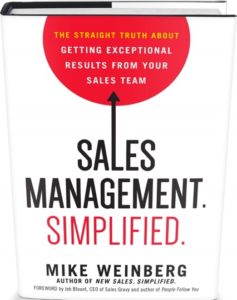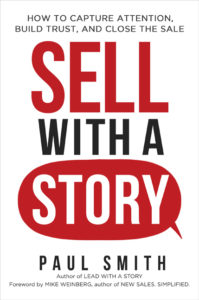Podcast: Play in new window | Download | Embed
Subscribe: RSS
Podcast (sell-with-a-story-series1): Play in new window | Download | Embed
Subscribe: RSS
 My guest this week is Mike Weinberg. He’s a sales consultant and bestselling author of two absolutely fabulous books, both of which spent a significant amount of time as the #1 selling book on Amazon for Sales and Selling. The first was New Sales. Simplified. And the second is Sales Management. Simplified. which we talked about on today’s show.
My guest this week is Mike Weinberg. He’s a sales consultant and bestselling author of two absolutely fabulous books, both of which spent a significant amount of time as the #1 selling book on Amazon for Sales and Selling. The first was New Sales. Simplified. And the second is Sales Management. Simplified. which we talked about on today’s show.
I asked Mike to share a couple of examples from his book of the type of things companies do that undermine their sales department, and put their sales management in a position where they can’t fix it. He didn’t disappoint.
About a third of our conversation is captured below. For the rest, you’ll need to listen to the podcast by clicking the play button above. It’s more fun than reading anyway.
Method #1: Bury the sales manager in crap
The first example Mike shared is from a chapter in his book titled You Can’t Effectively Run a Sales Department When You’re Buried in Crap. Here’s the example, as written in the book:
Last year I was hired by an industrial manufacturing company with a strong anti-sales culture. The COO brought me in to look at their sales process, help create a more proactive sales approach for their regional sales managers (who fancied themselves as sales engineers as opposed to salespeople), and to personally coach the director of sales on sales leadership. Due to aggressive cost cutting, the company was profitable despite flat sales resulting from a protracted slowdown in their particular space, the sales team’s lack of leadership and its reactive, pessimistic mode of operating.
 The COO warned me going into the assignment that I likely wouldn’t see much good sales management behavior in place because it was widely agreed that the director of sales was overwhelmed. The COO was correct. It was even a challenge scheduling my first coaching session with the director. That should have been a clue to the two dominant issues I quickly uncovered.
The COO warned me going into the assignment that I likely wouldn’t see much good sales management behavior in place because it was widely agreed that the director of sales was overwhelmed. The COO was correct. It was even a challenge scheduling my first coaching session with the director. That should have been a clue to the two dominant issues I quickly uncovered.
First, this long-time employee had pretty close to zero interest in being coached – by anyone, let alone by me. And second, to say that this poor man was overwhelmed would be the sales management understatement of the century! He was under water breathing through a straw in the midst of tsunami.
For the first half-hour, sitting in the director’s impressive, glass enclosed office, I just listened. He provided a history lesson about the company’s previous sales management failures over the past 15 years.
He then told me about the various types of meetings he was required to attend on a regular basis. The Production Planning Meeting. The Product Development Meeting. The New Strategy Meeting. The Executive Committee Meeting. The S & OP Meeting. There were more, but I stopped writing them down. When I asked to see his actual calendar, he smiled and gladly walked me over to the big flat screen on his desk. What I saw was unfathomable. There was practically no open space, and that’s not because he was time-blocking his high-value activities. All of a sudden, the bizarre placard on the wall in their men’s restroom started to make sense to me. (Shown below.)
 Was it in the realm of possibility that this company’s managers were so over-burdened that they were trying to combine their lunch and pee break into one event? You can’t make this stuff up. Another reason I love consulting!
Was it in the realm of possibility that this company’s managers were so over-burdened that they were trying to combine their lunch and pee break into one event? You can’t make this stuff up. Another reason I love consulting!
During the second half-hour of this initial sales management coaching session, I began asking the director a few basic questions to get a handle on how he was (wasn’t) leading the sales organization:
Me: Tell me how often you get out in the field to spend a day with one of your people.
Director: I don’t.
Me: Let’s talk about accountability for members of the sales team. When do you have one-to-one conversations to review sales results with the salespeople?
Director: I don’t.
Me: Okay. How about pipeline reviews, where you go over existing opportunities and what’s been added to pipeline recently?
Director: Nope.
Me: When are you doing team conference calls?
Director: I’m not.
Me: How certain are you about team members’ level of activity or that they’re even targeting the right customers and prospects?
He didn’t need to answer. We both knew that we found the problem in our first hour together.
But let me very blunt and very clear here. There was a lot of leadership sin to go around. Yes, clearly this head of sales was confused about his priorities. And he certainly was not taking ownership of his team, his calendar, or sales results. However, and I mean a big however, before throwing any more stones at this faithful, hard-working, long-tenured employee (who happened to be in the wrong job at the wrong time), let’s take just a quick look at the situation created for him.
- The director had 22 direct reports, 15 of which were the regional salespeople. The other seven were in support roles: service and marketing.
- He had no administrative assistance.
- The company mandated his attendance at all those non-sales management meetings mentioned above.
- I also remember the director of sales sharing that he was receiving in excess of 200 emails per day – many which did indeed require his response.
In reality, he could’ve worked 60 hours per week in 100 percent reactive mode and still not been able to handle all the work being put on his plate, let alone get to the proactive sales leadership priorities I was hired to help him master.
What a disaster.
Mike shared some of his ideas to prevent exactly this kind of situation. And then went on to share the second example. . .
Method #2: Make your salespeople miserable
Mike explained, “A miserable accountant can still do great work. The same is not true for a miserable salesperson.”
You can listen to his explanation of why, and the cringeworthy example he shared, starting at 12:24 into our discussion.
You can find Mike at www.newsalescoach.com.
[You can learn more about storytelling in sales in my book, Sell with a Story.]
—
 Paul Smith is one of the world’s leading experts on business storytelling. He’s a keynote speaker, storytelling coach, and bestselling author of the books Lead with a Story, Parenting with a Story, and Sell with a Story.
Paul Smith is one of the world’s leading experts on business storytelling. He’s a keynote speaker, storytelling coach, and bestselling author of the books Lead with a Story, Parenting with a Story, and Sell with a Story.


 Connect with him via email here.
Connect with him via email here.
Follow him on Facebook, LinkedIn, Twitter, and Instagram.
Sign up for his newsletter here to get one new story a week delivered to your inbox.

